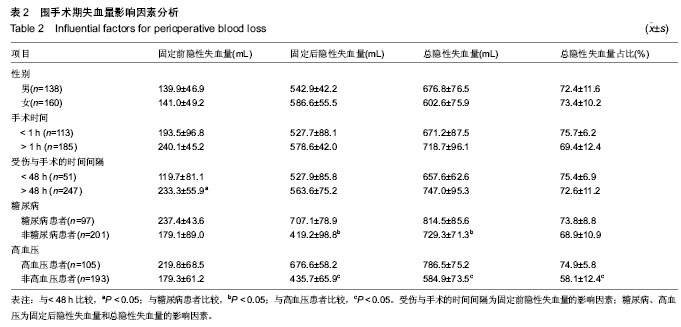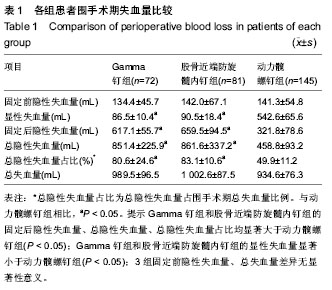| [1] 危杰.股骨转子间骨折[J]. 中华创伤骨科杂志, 2004,6 (5): 554-57.
[2] McCormack R, Panagiotopolous K, Buckley R, et al. A multicentre, prospective, randomised comparison of the sliding hip screw with the Medoff sliding screw and side plate for unstable intertrochanteric hip fractures. Injury. 2013;44(12): 1904-1909.
[3] Lee YK, Chung CY, Park MS, et al. Intramedullary nail versus extramedullary plate fixation for unstable intertrochanteric fractures: decision analysis. Arch Orthop Trauma Surg. 2013; 133(7): 961-968.
[4] Smith GH, Tsang J, Molyneux SG, et al. The hidden blood loss after hip fracture. Injury. 2011; 42(2): 133-135.
[5] Foss N, Kehlet H. Hidden blood loss after surgery for hip fracture. J Bone Joint Surg [Br]. 2006; 88(8): 1053-1059.
[6] Sehat K, Evans R, Newman J. How much blood is really lost in total knee arthroplasty? Correct blood loss management should take hidden loss into account. Knee. 2000; 7(3): 151-155.
[7] Peleg K, Rozenfeld M, Radomislensky I, et al. Policy encouraging earlier hip fracture surgery can decrease the long-term mortality of elderly patients. Injury. 2014; 45(7): 1085-1090.
[8] Ostrum RF, Tornetta P, Watson JT, et al. Ipsilateral Proximal Femur and Shaft Fractures Treated With Hip Screws and a Reamed Retrograde Intramedullary Nail. Clin Orthop Relat Res. 2013; 472(9):2751-2758.
[9] Do JH, Kim YS, Lee SJ, et al. Influence of fragment volume on stability of 3-part intertrochanteric fracture of the femur: a biomechanical study. Eur J Orthop Surg Traum. 2013; 23(4): 371-377.
[10] Chiavaras MM, Bains S, Choudur H, et al. The Radiographic Union Score for Hip (RUSH): the use of a checklist to evaluate hip fracture healing improves agreement between radiologists and orthopedic surgeons. Skeletal Radiol. 2013; 42(8): 1079-1088.
[11] D'Arrigo C, Carcangiu A, Perugia D, et al. Intertrochanteric fractures: comparison between two different locking nails. Int Orthop. 2012; 36(12): 2545-2551.
[12] McCormack R, Panagiotopolous K, Buckley R, et al. A multicentre, prospective, randomised comparison of the sliding hip screw with the Medoff sliding screw and side plate for unstable intertrochanteric hip fractures. Injury. 2013; 44(12): 1904-1909.
[13] Goffin J, Pankaj P, Simpson A. The importance of lag screw position for the stabilization of trochanteric fractures with a sliding hip screw: a subject-specific finite element study. J Orthop Res. 2013; 31(4): 596-600.
[14] O'Malley N, Deeb A, Bingham K, et al. Outcome of the dynamic helical hip screw system for Intertrochanteric hip fractures in the elderly patients. Geriatr Orthop Surg Rehabil. 2012; 3(2): 68-73.
[15] Kuzyk P, Zdero R, Shah S, et al. Femoral head lag screw position for cephalomedullary nails: a biomechanical analysis. J Orthop Trauma. 2012; 26(7): 414-421.
[16] Herman A, Landau Y, Gutman G, et al. Radiological evaluation of intertrochanteric fracture fixation by the proximal femoral nail. Injury. 2012; 43 (6): 856-863.
[17] Frei H, Hotz T, Cadosch D, et al. Central head perforation, or "cut through," caused by the helical blade of the proximal femoral nail antirotation. J Orthop Trauma. 2012; 26(8): e102-e107.
[18] Lawrence VA, Silverstein JH, Cornell JE, et al. Higher Hb level is associated with better early functional recovery after hip fracture repair. Transfusion. 2003; 43(12): 1717-1722.
[19] Gross JB. Estimating allowable blood loss: corrected for dilution. Anesthesiology. 1983; 58(3): 277-280.
[20] Zhu XZ, Tao YL, Ma Z. Routine blood tests as predictors of mortality in hip fracture patients. Injury. 2013; 44(11): 1659.
[21] Molyneux S, Rehman H, Brown G, et al. Admission blood tests significantly underestimate anaemia in hip fracture patients – A prospective cohort study. Int J Surg. 2013; 11(8): 660.
[22] Lin DM, Lin ES, Tran MH. Efficacy and safety of erythropoietin and intravenous iron in perioperative blood management: a systematic review. Trans Med Rev. 2013; 27(4): 221-234.
[23] Abraham A, Anatolie L, Marina A, et al. Blood transfusion requirements in elderly hip fracture patients. Arch Gerontol Geriatr. 2003; 36(1): 75-81.
[24] Carson J, Noveck H, Berlin J, et al. Mortality and morbidity in patients with very low postoperative Hb levels who decline blood transfusion. Transfusion. 2002; 42(7): 812-818.
[25] 罗涛,黄伟杰,吴伟,等.股骨粗隆间骨折围手术期隐性失血初步分析[J].实用骨科杂志,2011, 17(9): 796-799.
[26] 龙秋平,廖前德,科尹,等. 股骨转子间骨折两种置入内固定的隐性失血比较[J].中国组织工程研究,2013,17(30): 5460-5465.
[27] 贾晓龙,顾始伟,李永正,等.股骨粗隆间骨折Evans分型对围手术期隐性失血影响的临床回顾性研究[J]. 中国临床医师杂志(电子版),2012,6(13): 184-185.
[28] 刘志刚,张上上,陈如见,等.全髋关节置换后的隐性失血[J].中国组织工程研究,2013,17(13): 2305-2312.
[29] 韩天宇,周大鹏,田竞,等. INTERTAN治疗老年股骨粗隆间骨折围手术期隐性失血的初步分析[J].成都医学院学报,2013,8(3): 234-236.
[30] 张培训,薛峰,安帅等.股骨近端防旋髓内钉和动力髋螺钉治疗股骨粗隆间骨折的显性和隐性失血量分析[J].北京大学学报(医学版), 2012, 44(6): 891-894.
[31] 邱旭升,陈东阳,徐志宏,等.全膝关节置换术后隐性失血危险因素的分析[J]. 实用骨科杂志, 2012,18(6):510-512.
[32] 李志国,邢更彦,赵斌,等. Gamma3治疗老年股骨转子间骨折围手术期隐性失血的初步分析[J].中国骨与关节外科, 2012,5(3): 224-227.
[33] 李鹏,李金松,尹纪光.低分子肝素对人工全髋关节置换术后隐形失血的影响[J]. 实用中西医结合临床, 2011,11(5): 25-26.
[34] 高富强,李子健,张克,等.初次全膝关节置换术后隐性失血的影响因素研究[J].中华外科杂志,2011, 49(5):419-423.
[35] 罗永立,许汉权,庞祖才.胸腰椎骨折手术时机与隐性失血的相关性研究[J].吉林医学,2011,32(35): 7448-7449.
[36] 曹力,尼加提•阿不力米提,阿斯哈尔江•买买提明,等. 单侧全膝人工关节置换术后引流选择的随机对照研究[J].中华外科杂志, 2009,47(18): 1390-1393.
[37] Verettas DA, Ifantidis P, Chatzipapas CN, et al. Systematic effects of surgical treatment of hip fractures: gliding screw-plating vs intramedullary nailing. Injury. 2010; 41(3): 279-284.
[38] Kokoroghiannis C, Aktselis I, Deligeorgis A, et al. Evolving concepts of stability and intramedullary fixation of intertrochanteric fractures--a review [Review]. Injury.2012; 43 (6): 686-693.
[39] Hu F, Jiang C, Shen J, et al. Preoperative predictors for mortality following hip fracture surgery: a systematic review and meta-analysis. Injury.2012; 43(6): 676-685. |

